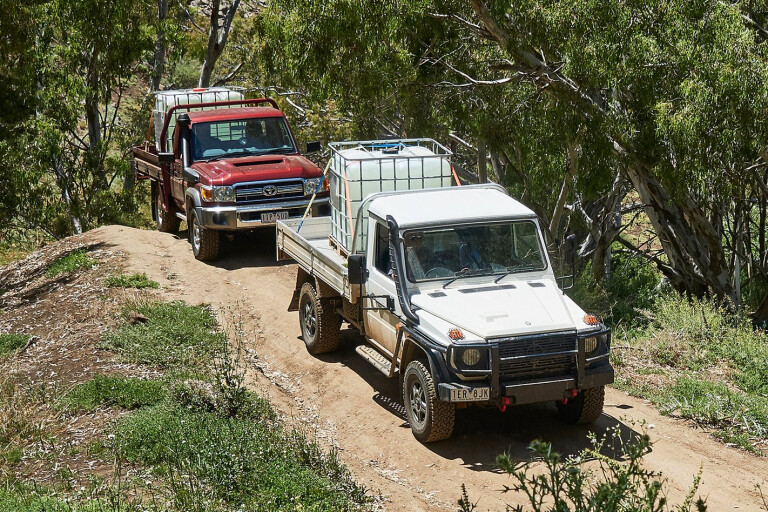
THESE two legendary vehicles have, over the past 30-plus years, carved a place in the annals of four-wheel drive motoring history.
While the Merc has rarely been seen in Australia until recently, its reputation has been etched in stone. Meanwhile the Land Cruiser 70 Series has built on its forebear’s tough and reliable reputation, not only in the harsh outback of Australia but also in Africa and beyond.
Watch how these two heavy-haulers battled it out here.
MERCEDES-BENZ G300 CDI PROFESSIONAL CAB-CHASSIS
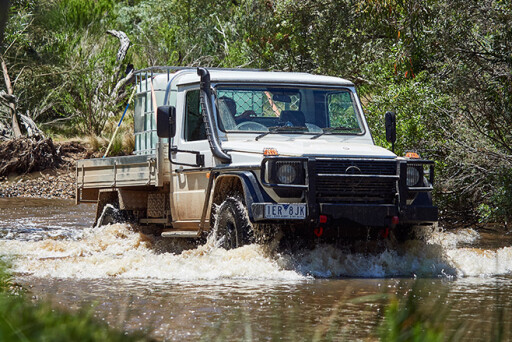 ON paper the Merc sounds pretty impressive, and in a 4WD and load-carrying sense you have to say it delivers the goods. However, there is absolutely no pandering to comfort, ambience or even on-road manners. But I’m getting a little ahead of myself.
ON paper the Merc sounds pretty impressive, and in a 4WD and load-carrying sense you have to say it delivers the goods. However, there is absolutely no pandering to comfort, ambience or even on-road manners. But I’m getting a little ahead of myself.
The Mercedes-Benz G300 CDI Professional cab-chassis looks like it comes from a bygone era. In fact, the basic body and chassis design hails back to the 1970s, predating the 70 Series Cruiser by quite a few years. Still, you don’t buy one of these rigs for its good looks or modern styling, but, as you’d expect, there’s been a few upgrades in other departments since it first appeared. Benz’s global and far-reaching 3.0-litre V6 turbo-diesel engine has been detuned for its role in the G-Class, so much so that it can reportedly run on the world’s poorest quality diesel fuel. That’s probably a good thing considering the numerous complaints we hear about diesel fuel out in the Aussie bush.
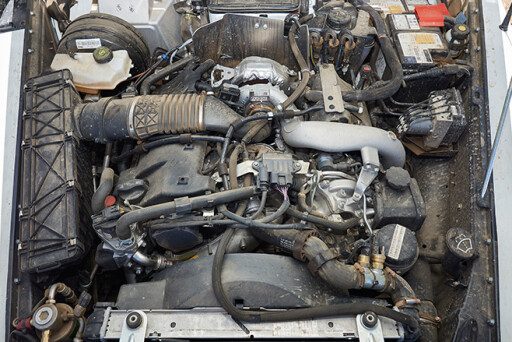 The engine, crowded into its engine bay, produces 135kW at 3800rpm and 400Nm anywhere between 1600 and 2600 revs. Without a heavy load and with a mix of on-road and off-road driving the Merc returned a fuel economy figure of around 16.0L/100km, which isn’t particularly brilliant in this day and age. With a fuel tank capacity of just 97 litres you’d be game to drive anywhere close to 600km before fuelling up.
The engine, crowded into its engine bay, produces 135kW at 3800rpm and 400Nm anywhere between 1600 and 2600 revs. Without a heavy load and with a mix of on-road and off-road driving the Merc returned a fuel economy figure of around 16.0L/100km, which isn’t particularly brilliant in this day and age. With a fuel tank capacity of just 97 litres you’d be game to drive anywhere close to 600km before fuelling up.
The engine produces a lot of heat (as all do), but the crowded engine bay means the hot air enveloping the engine has a hard time escaping from underneath the bonnet. Apart from nearly suffering first-degree burns when lifting the bonnet after an hour or two of 4WDing, I’m not sure how long the battery will last in those hot confines.
A basic five-speed automatic transmission sends drive to all wheels with a 50:50 split front to rear, and the centre diff can be locked by a switch on the centre dash. Low range can also be selected by a switch to deliver an impressive, tractor-crawling 41.0:1 in low first. For more 4WD capability, standard front and rear axle diff locks are also controlled by a couple of switches on the dash.
 There are heavy duty coil springs all around designed to carry a payload (which includes the weight of any tray you fit) of nearly 2100kg, and a braked towing capacity of 2120kg is a much more realistic figure than what most utes on the Aussie market profess to have. With its
There are heavy duty coil springs all around designed to carry a payload (which includes the weight of any tray you fit) of nearly 2100kg, and a braked towing capacity of 2120kg is a much more realistic figure than what most utes on the Aussie market profess to have. With its
heavy-duty chassis, and crossmembers that would do a truck proud, it’s surprising that the kerb weight is just 2410kg. Two spare tyres tuck under the aftermarket tray on this example.
Adding to the old-school-but-excellent diff locks, the G-Professional comes with a range of electronic driving and safety enhancements. There’s ABS, electronic stability control with selectable on/off function, brake assist and electronic brake-force distribution. A tyre-pressure monitoring system along with just two airbags are also standard fair and, while the G-Pro hasn’t received an ANCAP safety rating yet, the vehicle has won favour with a number of mining companies and government departments across Australia.
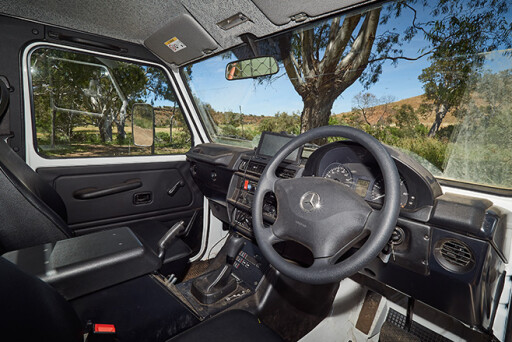 In the cab you get two basic bucket seats, a centre console that’s not for storing anything, absolutely no lining or sound deadening, and some cheap rubber mats. Switch controls, apart from the aforementioned 4WD and diff-lock buttons, are robust, ungainly and hard to use.
In the cab you get two basic bucket seats, a centre console that’s not for storing anything, absolutely no lining or sound deadening, and some cheap rubber mats. Switch controls, apart from the aforementioned 4WD and diff-lock buttons, are robust, ungainly and hard to use.
The G-Professional doesn’t come cheap, setting you back $119,900 plus on-road costs. For that you also get 16-inch alloy rims sporting 265/75R16 AT rubber, a bullbar, snorkel, radiator and sump protection plates, along with headlight and indicator light guards. The tray is an extra cost.
TOYOTA LAND CRUISER 79 SERIES V8 SINGLE CAB-CHASSIS
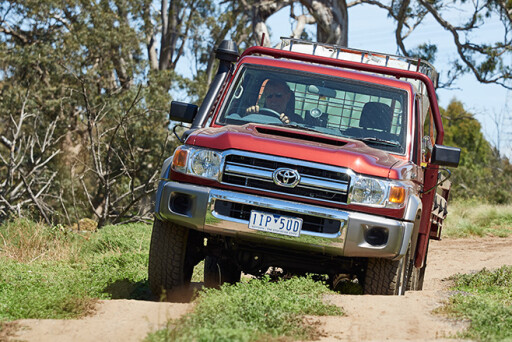 The 70 Series Land Cruiser may have been with us since the 1980s, but for many outback tourers, farm hands and mining exploration teams this is still the vehicle of choice.
The 70 Series Land Cruiser may have been with us since the 1980s, but for many outback tourers, farm hands and mining exploration teams this is still the vehicle of choice.
The latest upgrade to the single-cab Cruiser is mainly the result of pressure from mining companies to improve the safety rating to ANCAP 5 standard (only the single-cab rates this high), while also correcting some other long-standing issues and improving environmental emissions.
The 4.5-litre turbo engine gets piezo injectors and a diesel particulate filter, but power and torque remain the same at 151kW at 3600rpm and 430Nm at 2000 revs. Fuel economy has improved slightly, but our real-world testing didn’t see much difference with a figure of around 14.0L/100km. Now with the smaller 130-litre tank (down from dual 90-litre units) range should be about 900km between refills.
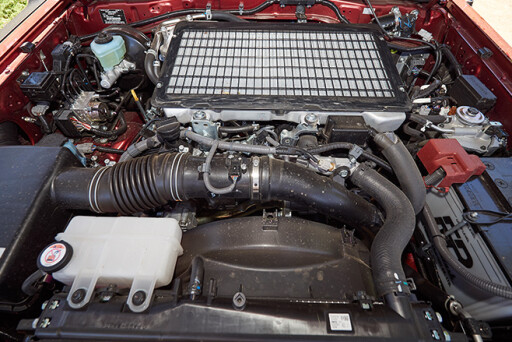 The big mechanical change in the 70 Series is the gearbox ratios, with second and top gears being significantly taller. The taller top gear will be welcomed by many, with the engine spinning around 2000rpm at 100km/h. The proven and well-tried part-time 4WD system remains the same, with auto-locking hubs now gracing the front axle. Overall reduction in low first is also a very credible 45.9:1. GXL variants get front and rear diff locks as standard fare.
The big mechanical change in the 70 Series is the gearbox ratios, with second and top gears being significantly taller. The taller top gear will be welcomed by many, with the engine spinning around 2000rpm at 100km/h. The proven and well-tried part-time 4WD system remains the same, with auto-locking hubs now gracing the front axle. Overall reduction in low first is also a very credible 45.9:1. GXL variants get front and rear diff locks as standard fare.
There are live axles all around with coil springs up front and leaf springs down the back end for carrying the load. Kerb weight is 2175kg while GVM is 3300kg, giving a payload of 1125kg. Braked towing capacity is a realistic 3500kg.
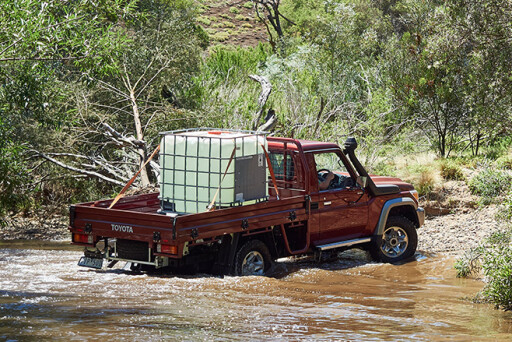 The biggest bugbear of the latest 70 Series Cruiser has been the difference in track between front and rear. Sadly, this hasn’t been addressed, which will keep some in the aftermarket industry happy, as conversions to widen the back end are seemingly proliferating.
The biggest bugbear of the latest 70 Series Cruiser has been the difference in track between front and rear. Sadly, this hasn’t been addressed, which will keep some in the aftermarket industry happy, as conversions to widen the back end are seemingly proliferating.
The addition of electronic driving and safety features brings the 70 Series into the modern world, with this Cruiser now featuring ABS, vehicle stability control, active traction control, hill-start assist, brake assist and electronic brake-force assist. All this is designed to make a poor driver a reasonable one and, with the help of five airbags (driver and passenger, side curtains and driver’s knee) along with chassis improvements, ensures the vehicle receives an ANCAP rating of five stars. Cruise control is now standard in the GXL.
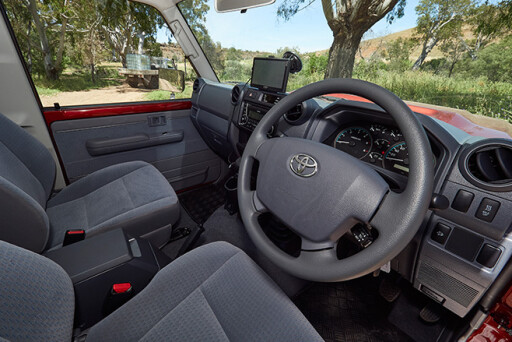 In-cab comfort has been improved with better seats and improved NVH, with the GXL model getting ‘almost plush’ carpet and cabin trimmings. Switch controls are sensibly laid out and easy to use. The GXL on test here has a price tag of $66,490 plus on-road costs. Optioned as it is here with painted steel tray and air conditioning ($2700) it sits at $74,715.
In-cab comfort has been improved with better seats and improved NVH, with the GXL model getting ‘almost plush’ carpet and cabin trimmings. Switch controls are sensibly laid out and easy to use. The GXL on test here has a price tag of $66,490 plus on-road costs. Optioned as it is here with painted steel tray and air conditioning ($2700) it sits at $74,715.
HEAD TO HEAD
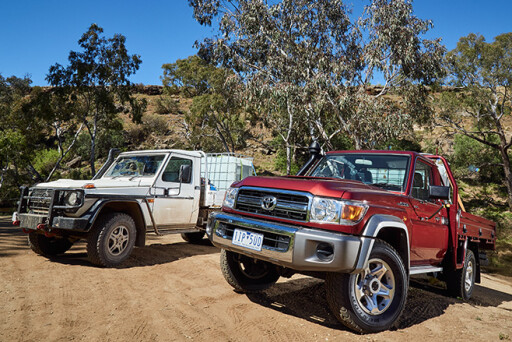 YOU’LL notice the Spartan condition of the cabin immediately once you get into the G-Pro, which almost makes the Cruiser look and feel luxurious in comparison. You’ll notice it even more when you are moving, especially at 110km/h on the freeway.
YOU’LL notice the Spartan condition of the cabin immediately once you get into the G-Pro, which almost makes the Cruiser look and feel luxurious in comparison. You’ll notice it even more when you are moving, especially at 110km/h on the freeway.
Loading up both vehicles with 1000 litres of water sent the Cruiser to its maximum GVM (as standard, although there are many upgrades in the aftermarket), which resulted in its back-end squatting down quite a bit. The same weight on the Merc settled the suspension a little but, being only half the maximum allowable payload, did little else. Certainly the vehicle’s stance and drivability was hardly affected, with the longer wheelbase helping here. In fact, the suspension offered a much better ride with this weight being carried than when it was empty or lightly loaded.
On the other hand, when the Cruiser was loaded the steering was light and, on corners and roundabouts, it had a wallowing back-end. Still, when the trays were empty or close-to empty the Cruiser was much more comfortable and pleasurable to drive. The Merc was a pig of a thing when empty, especially on slightly bumpy or corrugated tracks.
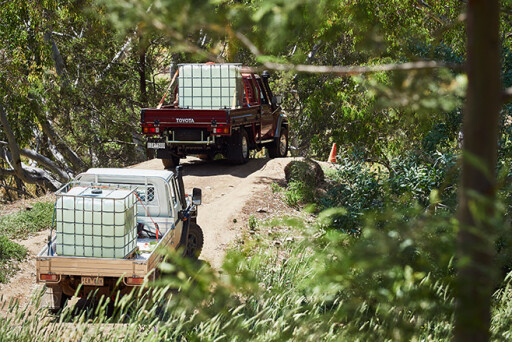 While the Merc’s performance was hardly blistering it performed adequately, even though you had to be very positive with the accelerator to get it to go – the engine did feel the extra tonne on the back. In comparison the Toyota V8 hardly felt the extra burden and we often took off from a standing start in second gear. Mind you, the auto ’box in the Merc was a highlight, making the manual ’box in the Tojo feel almost archaic.
While the Merc’s performance was hardly blistering it performed adequately, even though you had to be very positive with the accelerator to get it to go – the engine did feel the extra tonne on the back. In comparison the Toyota V8 hardly felt the extra burden and we often took off from a standing start in second gear. Mind you, the auto ’box in the Merc was a highlight, making the manual ’box in the Tojo feel almost archaic.
Lighting and air-conditioning controls in the Merc are woeful and the whole cab layout leaves a lot to be desired. The Cruiser mightn’t be the epitome of design and comfort, but it is way in front of the Merc. You’d also have to put this latest variant of the Cruiser in front of the Merc when it comes to safety, although both offer outstanding 4WD capability.
Then there’s the significant price difference. I never thought I’d say this but the 70 Series Cruiser is remarkably good value for money; certainly when compared with the Merc. For my money I’d take the Cruiser every time. The only time I’d consider the Merc is if I was hauling one-tonne or heavier load all the time... and I mean all the time.
SPECS
 Toyota Land Cruiser LC79 GXL
Toyota Land Cruiser LC79 GXL
Engine 4.5-litre 1VD-FTV 8-cylinder turbo-diesel
Power 151kW @ 3600rpm
Torque 430Nm @ 2000rpm
Gearbox five-speed manual
4X4 System dual-range part-time
Crawl ratio 44.1:1
Tyre spec 265/70R16 115R
Kerb Weight 2175kg
GVM 3300kg
Payload 1125kg (with no tray)
Towing 3500kg
Fuel tank capacity 130 litres
ADR fuel claim 10.7L/100km
Fuel consumption 14.0/L/100km
Warranty 3-years/100,000km
Price $66.490
Price As Tested $74,715

Engine 3.0-litre V6 turbo diesel
power 135kW @ 3800rpm
torque 400Nm @ 1600-2600rpm
Gearbox five-speed automatic
4X4 System dual-range full-time
Crawl ratio 41.0:1
Tyre spec 265/75R16
Kerb Weight 2410kg
GVM 4490kg
Payload 2080kg (minus tray weight)
Towing 2210kg
Fuel tank capacity 97 litres
ADR fuel claim N/A
Fuel consumption 16.1L/100km
Warranty 3-years/ 200,000km
Price $119,900 (excluding tray)

COMMENTS